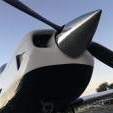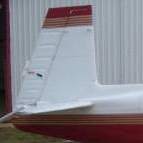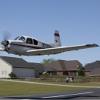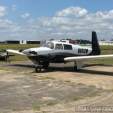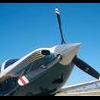Leaderboard
Popular Content
Showing content with the highest reputation on 11/14/2017 in all areas
-
If you insure your plane for too much, in the event of an accident, the insurance carrier may opt to repair, rather than pay out the full cost. If you insure for too little, you risk not getting enough to replace it. Plus the carrier will not insure it for a grossly exaggerated number. In my opinion, you should stick close to the real replacement value, a little on the high side.4 points
-
I'll really try to refrain... but I seem to be afflicted with the same psychosis as @Marauder and @Bob_Belville. Likely something to do with searching for approval and validation of our gross over "investment" in our vintage airplanes.3 points
-
Hi All, Bruce Jaeger (former Willmar MSC owner) will be coming to my airport (N57) the week of December 4th to install his Spatial Interior product in my Mooney. The installation will be done in my hangar and Bruce will be demonstrating the installation process as well as his repair techniques for the wonderful plastic we have in our planes. If you have an interest in stopping by, drop me a PM and I will provide details on the logistics. http://www.jaegeraviation.com/sinteriors2 points
-
My renewal is coming up and I am asking bidders to insure my '66E for $100,000 hull. This is above their guidelines for make and model so one of the underwriters requested a spec sheet. I provided the list below and they accepted the value. I consider this a fair compromise. $100k is above "market value" but below replacement cost. If major work has been done, particularly to the panel, it is important to set the insured value high enough that in the event of a repairable event such as a gear up landing that's going to mean a claim of $30-40k or more that the adjuster doesn't calculate that his best loss is to pay you the agreed hull value, save himself the repair costs and sell the plane including the avionics which he now owns as salvage. @Amelia's belove M20K is a recent case where the adjuster did just that. N943RW 1966 Mooney M20E serial 929 1966 M20E Airframe TT 3,115 as of 11/3/2017 Lycoming IO360 A1A 985 SFRM 222 Since IRAN by Triad. Prop - Hartzell Top Prop Scimitar 222 new 2015 Upgrades: New 3/16" solar grey windows all around w door vent window Dec. 2015 PowerFlow Exhaust new 2012 Fine wire plugs new 2012 leather interior new 2012 "201" style windshield 201 panel/glareshield (complete new panel 2012 better than 201!) 201 style cowl Plane Power 70A alternator/VR new 2012 Concorde RG 35 AXV battery new 2015 External power plug Avionics and Instuments: Auto pilot - STEC 50 w Alt Hld Stormscope - WX-900 overhauled 2012 Aspen PFD 1000 - with Synthetic Vision, traffic, AOA, w GPSS new 2012 GPS - Garmin GTN 750 new 2012 Garmin FS 510 new 2016 Garmin GDL 88 - ADS-B in & out -traffic, weather - feeds GTN and Aspen new 2012 Garmin GPS 696 - hard wired and linked to GTN new 2012 CYA100 AOA new 2015 JPI EDM 930 new 2012 KX155 w GL #2 NavCom Garmin GTX 327 Xponder new 2012 Garmin GMA 340 Audio Panel new 2012 Other Upgrades and STC'd Modifications: Oil cooler relocated by Lake Aero Style STC SA2513NM Fiberglass nose cowl by AeroResources Inc STC SA7589SW Mooney 201 M20J Spinner & spinner bulkhead assys from Aero Resources Inc STC SA7589SW Speed brakes by Precise Flight Inc STC SA5708NM Mooney Bladder Tank 6 bay system by O&N Aircraft Modifications Inc STC SA2350CE Dorsal Fin Fairing by Lake Aero Styling, STC SA4443NM Tail Root Fairing Horizontal by Lake Aero Styling, STC SA4443NM Wheel well liner covers by Lake Aero Styling, STC SA4443NM Wing Root Leading Edge Fairing by Lake Aero Styling, STC SA4443NM Relocated Cleveland wheel brake assys by Lake Aero Styling, STC SA4443NM Hinge cover on Aileron, Elevator, & Rudder assy by Lake Aero Styling , STC SA4443NM Aileron lower gap seals by Lake Aero Styling, STC SA4443NM Flap gap seals by Lake Aero Styling, STC SA4443NM One piece fiberglass belly pan fairing with skid runners by Aero Mod Inc, STC SA4080NM CiES fuel level sensors and add on bladders (to 64 gallons) scheduled Dec. 20172 points
-
What is the shop's labor rate? You can calculate out what those 40 hours will cost. The PS Engineering box should around $1800 plus a lot of installation. The numbers you posted seem reasonable. WORDS OF ADVICE: Make sure they are working off of a quote. Can't tell you the number of times a shop tried to pull this was an "estimate" on me when the paperwork clearly stated "quote". What this means you need to have them look over your plane in person before they quote it.2 points
-
I don't think that's excessive. Your premium probably wont shift much going from 60-70-80. You just have to decide if you'd be okay looking for a new plane if your plane was totalled, and you were given $XX. Mine is insured at 60k, and I'm thinking about raising it.2 points
-
I ran VREF. Since you did not give a TT, I used the standard 4040TT. It gives credit for the GTN-650, EDM 380, Strikefinder, Alt Hold, and nice interior, but, surprisingly, nothing on the G5s. End result is: 1967 - MOONEY SUPER 21/EXEC M20 E/F $65,400.00 (as configured) I have been thinking a lot about this, too. I bought my 201 about 2 years ago for $69,500. VREF now shows it worth about $84,000. Replacement value is foremost in my mind, as my dad landed his T-210 gear-up recently, and the repair bill was quoted between $80,000 and $110,000! Unbloody believable, as the only visible damage is 3 square feet of skin and the prop. ( He made a perfect landing. The investigator noted 16 prop slashes on the centerline.)2 points
-
For me, the G5 HSI is of value because I don't have GPS Roll steering. I have to turn the indicator at each course change - it wont' follow the magenta line. Instead of installing a DAC for Roll Steering, it makes more sense for me to install a G5 HSI with the GAD-29B to talk to the autopilot. It is my understanding that a G5 AI cannot take over and send the Flight Director signals to the King autopilots.2 points
-
GAD 29b doesn't remove requirement for attitude outputs for attitude-driven autopilots. It only provides analog emulation of a legacy HSI or DG input. For a TC autopilot like STEC, yes the heading bug on the G5 HSI will drive the autopilot. One of the benefits for us legacy autopilot folk for the G5 HSI is that GPSS is built in to the G5. I'm about this close to purchasing the G5 HSI...2 points
-
Remember that market value is not replacement cost. Factor in travel and pre purchase. Also taxes (9% here) -Robert2 points
-
I'm in a 78J and am upgrading to similar avionics. It has Good paint and interior. I insured for $105k. I couldn't buy and upgrade a J to this level for $105k but could probably buy one similarly equipped in the $100-$120k range. You could probably get a very nicely equipped F for $80k. Hope this helps.2 points
-
I respectfully disagree. The insured stated or agreed value has everything to do with a realistic market value. There needs to be an objective baseline of what it would take to replace the aircraft. This is an accurate market value and should be reviewed and adjusted periodically if necessary.2 points
-
I believe insurance needs to be enough to allow me to replace the plane with another of the same type at the market price... but not so much that the insurance company won't total the plane if it's sustained major damage that will seriously affect resale after the repair. I've tended to insure my Mooney's on the high end as they've both been very well equipped and I knew it would take top dollar to replace them. There have been a couple of examples of people who insured their plane for just what they paid for it, and then an accident totals the plane and the resulting payout isn't really enough to replace it.2 points
-
Insurance hull value has very little to do with market valuation. It's whatever you can convince them to write the policy for and are willing to pay the corresponding premium.2 points
-
Just in case y'all need some tears this morning https://wishesdelivered.ups.com/girl-pilot/2 points
-
FWIW a buddy has a <10 year old Cirrus and he routinely pays $15,000+ for annuals. He has had a few things happen to the fiberglass body over the years, and it seems that each time the Cirrus factory has to do an engineering study to determine how to make the repair. I am a big fan of the 4130 "roll cage" and sheet metal aluminum. I'll stick with Mooney.2 points
-
Bob From CFR 14, 1.2: VS means the stalling speed or the minimum steady flight speed at which the airplane is controllable. VS0 means the stalling speed or the minimum steady flight speed in the landing configuration. Key words for this discussion are or minimum steady flight speed. I have started to notice this terminology in some definitions of these V speeds and with reference to the white arc. The CAA regulations seemed to give some room in defining the bottom of the white arc. It seems to me, the bottom of the Mooney white arc is minimum steady state flight and not stalling speed. This might explain the disparity and seems like a logical way to mark an airspeed indicator, it actually gives some margin. I wonder if this corresponds to the point where the stall horn is supposed to come on, maybe I’ll try some stalls this weekend to check. If this theory is correct, I think the fault with the Mooney manual is simply that they didn’t define it this way, when other OEMs can and do use bottom of the white arc for stall speed. As a side note, I checked with one of our aero guys, but it was not obvious to him. Of course, we tend to work on whirly wings, so we don’t look at a stall the same way.....2 points
-
Both Vso and the ASI white arc were well defined under CAR 3 and meant the same thing as they do today. You can find the definitions in sections 3.82 and 3.757.2 points
-
That's a fair point. I would guess however that you probably have the decency not to circle a crash site and shoot video in the first place. This young voyeur just really, really disappointed me.2 points
-
My plane is in the shop now getting two g5’s and gad29b Installed. Should be completed this week. PIREP to follow.2 points
-
Glad you're still alive! Now where do you come down on the touch and go issue?2 points
-
This thread makes me want to go lookup a similar thread I started before beginning my Mooney transition training last February. Almost all my flying previous to buying the Mooney was tailwheel. I even started threads on here and another pilot forum asking if I was biting off more than I could chew with such a wild idea as the unobtainable goal of learning to fly a Mooney. In the course of my lack of self confidence, I saw that there was going to be cross wind on the day my C was to be delivered and thought I was doomed. At the time there were two schools of thought regarding crosswind and everything else about the impossible task of a non Mooney pilot being so brazen as to believe that he could ever transition without an instructor with a thousand hours or more and at least 100 students successfully transitioned to the impossible to fly and mysterious Mooney. The other school of thought was those who shrugged their shoulders and said something like “what’s the big deal it’s just another airplane?” I read all the posts about the early C’s not having enough rudder authority and all the other warnings implying that I would die in a crosswind. All the time while selecting flowers I did not consider my own landing technique in my little Cessna 140 in which I had logged about a thousand landings to include gusty and variable crosswinds. My crosswind technique from the very beginning was “ just enough rudder to keep it parallel to the runway and just enough aileron to keep it on the centerline and not drifting one way or the other.” As luck would have it, the day my instructor delivered the plane to my home field and began my transition training the wind was forecast to change to a gusty crosswind. In addition, it was a day of pretty choppy winds. After all the you will die advice from the naysayers that doomed the lowly Cessna 140 pilot to sure death I notified the funeral home of the assured business and got in the plane anyway. We started doing landings and I worked to learn the landing gear and getting the feel of the airplane in the flair. After most of the day of landings less than perfect, but acceptable, we knocked off for the day, had dinner and I put him in a hotel for the night. Once I got to the house that night, it occurred to me that I had been crosswind landing in a 13 knot or more gusty crosswind all day and was still alive and really the crosswind was a non event not noticed due to focusing on everything else. Although I was not greasing it in as I would have liked, this thing was much easier to deal with in a crosswind than the little putt-putt I had been flying all this time. NOW!.... I said all that to make this point: I realize that there is a school of thought and even verbiage in Airman’s manuals that pretty much dictate crab into the wind and straighten up at the last minute, BUT using the crosswind technique I was taught by the old school tailwheel instructor allows you to handle all the crosswind that a normal human being would want to fly in. I join those who recommend transition training be done by a Mooney savvy instructor, but if you are experienced at crosswind landing with the technique I described, crosswinds will be nothing new at all and if you can do them in a taildragger, or the same technique in any airplane, you won’t even know there is a crosswind.. You will just put her down. Landing a Mooney in a crosswind is like anything else with a Mooney. Just learn the right techniques and go enjoy yourself. As I recall Mooney indicated that an 11 knot crosswind is not a crosswind in an early model. I contend that the number is much higher than that if you use the right technique.2 points
-
I have a 96 Ovation. Maintenance has been almost exclusively normal wear and tear items. Most years I spend under 4K on maintenance including annual inspection. It’s a near perfect high performance single unless you want a turbo. So fuel efficient, engine runs cool even without cowl flaps. I don’t believe there are any recurring ad’s at all. If I could change anything would be 100lbs more useful load and a bit stronger landing gear. Other than that, it’s perfect. I’ll do the 310hp stc when the engine needs overhaul. Looks like I’ll comfortably exceed TBO by a fair amount. May you never see it for sale, I hope to own it many years until I can’t fly it any more. And by then maybe the kids will want it. I do hope scarcity will only help it’s value, the early ones always seem a good value to me. Sent from my iPhone using Tapatalk2 points
-
So I am driving in to work today and realized that I practice a great deal of situational awareness while almost all other drivers appear catatonic, staring ahead and never looking around. It made me wonder if being a pilot has done that to me. I check my instruments, adjust the GPS (even if I don't have a route entered), look all around. My daily driver is a track car and German, so it is very fast, nimble and engineered for driving. I could say the same thing about my E as far as aviation is concerned. When whizzing through the neighborhood I am scanning ahead and looking under cars to see if a kid might be in front of one, I'm quick to dodge potholes, looking out for any movement, watching for jackasses running stop signs, etc. Not bragging about my driving skills, but just wondering if any other pilots drive their cars the way they fly their airplanes? I'm grounded with an engine issue, so maybe I'm just compensating.1 point
-
As an Ovation driver I sometimes look at what the used market is doing. Is it just me or does it seem like there are very few used Ovations for sale these days? A quick-and-dirty scan yielded about 410 registered M20R's; there are 6 for sale at ASO, 9 at the Controller, and 3 at Trade-a-Plane (all on-line). That is less than 5% of the fleet. There are about twice as many Cirri on the registry (non-turbo; best I can figure); but there are tons of used ones for sale. Just wondering if anyone else has this impression. And if that is the case, why? (GREAT planes maybe?)1 point
-
You're inserting yourself into pretty fast company... but your 252 does not qualify as vintage.1 point
-
Plus it will give you a chance to post another picture of your instrument panel! (Written out of jealousy, not anger.)1 point
-
I have to agree with @Skates97 it all goes to mission. My mission is the Joy of Mooney. I love flying it, I love working on it, I love looking at it. Yes, a bit creepy, but what can I say? As for aspiring ATP's, a lot of ex ones own Mooneys, there's a reason. As for aspiring A&P's, repairing Mooneys tests the mettle of any man, or woman for that matter. Whenever I complain to my IA that something was a PITA to get at, remove and or replace he just says "Welcome to my world!" As for aspiring pilots in general, there is a continuing myth that Mooneys are hard to fly. That is nonsense, they almost fly themselves1 point
-
Flew a Tiger for a couple of years and loved it. Stepped up to a K not a J. Major differences were: - heavier controls not as nice and easy as in the Tiger - a lot more stable in turbulence and during approaches - Tiger is more a low altitude airplane - Visibility and cabin access in the Tiger is much better - much better grass field capability (Tiger) - Performance improvements were significant - higher maintenance costs although the Mooney is not so bad Hope that helps1 point
-
It's actually the outer wing that is designed to stall later and thus retain aileron effectiveness - our inboard stall strips are placed to make the wing root stall early. Also being at Vso should still allow stable flight with stall horn blaring if over the runway in ground effect.1 point
-
They don’t know what improvements and new equipment you’ve installed since last renewal. My agent said they insure the avionics at full price but don’t consider the labor involved. So when I gave then a list of new equipment, they asked for equipment costs.1 point
-
Thanks. Curious how that unit priced out. I went with the ESI-500. Primarily because I wanted to have a separate Nav head in addition to an approved standby AI. I did need to add in the Nav enablement so it could channel the GPS or ILS/VOR signals. That jacked the installed price up to $6500.1 point
-
Does that mean that your insurance quote is based on an inventory of your avionics, aircraft TT and SMOH, paint and interior condition, etc? I don't think that my broker has asked me for that information.1 point
-
They will let you know if you try to insure it for too high or too low a stated value. They require your signature if you try to insure it too low. For your protection.1 point
-
I would do as Cobra suggests below. Load up all of those high priced additions you made and set the hull to cover the VRef. The last thing you want to do is not insure for enough to cover what you have in the plane. I have never had an issue for insuring for the VRef.1 point
-
1 point
-
I agree with the FlightStream, but the FS 510 is only compatible with the GTN series. The FS 210 will also give you a back up AHRS. I just upgraded to the FS510 for my 750 and the interfacing is awesome. I file within ForeFlight, sometimes I get back and expected route via FF and then can push that to the panel upon verifying with Clearance Delivery in the plane without keying every point into the 750.1 point
-
Nice upgrade list. Another upgrade thought—a FlightStream 510 or 210 is an inexpensive addition that will make flight planning, plan entry and editing from your iPad far easier than directly into 430. Welcome to the 21st century.1 point
-
I have some thoughts about the avionics quote. It’s exciting. Now wait for the excitement to be tempered by the peanut galley. Standby.1 point
-
The M20J has a Vso of 55 KIAS and, in the corresponding chart of stall speed vs bank, a stall speed of 54 KIAS in landing configuration. I guess it doesn't have a 5 knot uncontrollable "dead zone" like the M20E.1 point
-
20 years ago, I bought my C model specifically for my son to build flight time after he got his private. I had no intention of keeping the plane once he was done. I only considered bang-for-the-buck for this particular mission...time building. Logged complex time is more valuable when looking for employment and when my son got that all important first jet job, his employer specifically mentioned the Mooney time that put him ahead of all the other low-time pilots trying for the job. Today, my son is a pilot for SWA (proud dad, here). Once the C had fulfilled its mission, I found it to be a delightful airplane and a great travelling machine. Had I bought a plane for myself, I might have bought a Bonanza, but once experiencing the Mooney's economics and reliability, I think we found the perfect plane.1 point
-
Ha, that is one of the best lines I have read here lately. That is almost like saying after I pay for this one upgrade...1 point
-
Bob 5kt is more than I would expect, but this could have been Mooney’s or the CAAs definition of “safe”. After all, the stall horn is typically set to go of 5-7kt higher than actual stall. Making the white arc correspond to the bottom of the white arc may make sense in this context. Will keep thinking about this one. I do suspect that Aspen would want the white arc to match the ASI, but I agree it would be good to understand.1 point
-
soon! I have my IFR checkride in december.... finally. After im done with all that practice I can play again.1 point
-
They put a strobe on it this morning and when the tach is showing 2,700 it is actually only turning at 2,610-2,615 so the tach reads almost 100 rpm high. They checked the governor and couldn't find anything that seemed wrong and will do some more checking and run-ups after they get the EDM830 in and they can get better data.1 point
-
I have a C model with short rudder. In a stiff crosswind what works best for me is the crab approach (no flaps and extra speed) then low wing JUST before touchdown. I will let it dissipate some energy on the flare but not nearly as much as in a typical landing. I set her down a little faster than normal but I retain good control throughout. Practice and you will be surprised how well even a short rudder Mooney handles a crosswind. Sent from my iPad using Tapatalk1 point
-
I've yet to find too much crosswind, but my C has the full length rudder. There is no "limitation" for iur planes, because Mooney didn't write one for us. Practically speaking, pilot ability is more of a limit than the airplane. You're at your crosswind limit when you can't keep the nose aligned with the runway centerline.1 point
-
1 point
-
Hahaha... Either. But I actually meant the overhaul. I subscribe to the school of thought that engines don't just suddenly quit, but rather give lots of warning, even if very subtle. I would not euthanize an engine giving no indication of problems from careful and regular analysis of engine monitor data, oil analysis, and borescope inspections, regardless of the hours.1 point
-
Or you can buy the laser jack/tie down points. Open up the wing panel get a nut grind off part of it and screw it all together. Replace access cover.1 point


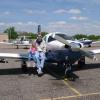
.thumb.png.7c67574d7b28f67b0b4a17760919b1ac.png)


